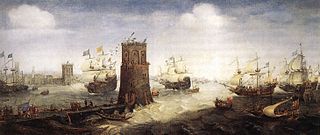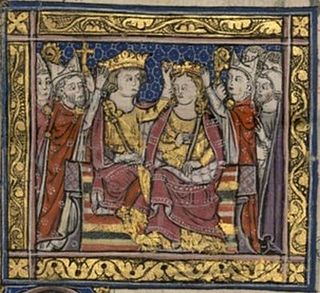
Year 1220 (MCCXX) was a leap year starting on Wednesday of the Julian calendar.

Year 1221 (MCCXXI) was a common year starting on Friday of the Julian calendar.

Year 1218 (MCCXVIII) was a common year starting on Monday of the Julian calendar.

Year 1219 (MCCXIX) was a common year starting on Tuesday of the Julian calendar.

Year 1169 (MCLXIX) was a common year starting on Wednesday of the Julian calendar.

Year 1249 (MCCXLIX) was a common year starting on Friday of the Julian calendar.

John of Brienne, also known as John I, was King of Jerusalem from 1210 to 1225 and Latin Emperor of Constantinople from 1229 to 1237. He was the youngest son of Erard II of Brienne, a wealthy nobleman in Champagne. John, originally destined for an ecclesiastical career, became a knight and owned small estates in Champagne around 1200. After the death of his brother, Walter III, he ruled the County of Brienne on behalf of his minor nephew Walter IV.
Boniface I, usually known as Boniface of Montferrat, was the ninth Marquis of Montferrat, a leader of the Fourth Crusade (1201–04) and the king of Thessalonica.

The Fifth Crusade (1217–1221) was a campaign in a series of Crusades by Western Europeans to reacquire Jerusalem and the rest of the Holy Land by first conquering Egypt, ruled by the powerful Ayyubid sultanate, led by al-Adil, brother of Saladin.
William of Montferrat, also called William Longsword, was the count of Jaffa and Ascalon, the eldest son of Marquess William V of Montferrat and Judith of Babenberg. He was the older brother of Conrad, Boniface, Azalaïs, and Renier, and a cousin of both Emperor Frederick I and King Louis VII of France.
Renier of Montferrat (1162–1183) was the fifth son of William V of Montferrat and Judith of Babenberg. He became son-in-law of the Byzantine Emperor Manuel I Komnenos and Caesar in 1180, and was later murdered in a Byzantine power-struggle.

Judith, a member of the House of Babenberg, was Marchioness of Montferrat from 1135 until her death, by her marriage with Marquess William V.

The siege of Damietta of 1218–1219 was part of the Fifth Crusade in which the Crusaders attacked the Egyptian port city of Damietta. The city, under the control of the Ayyubid sultan al-Kamil, was besieged in 1218 and taken by the Crusaders in 1219.

Guérin de Montaigu, also known as Garin de Montaigu or Pierre Guérin de Montaigu, was a nobleman from Auvergne, who became the fourteenth Grand Master of the Knights Hospitaller, serving from 1207–1228. He succeeded the Grand Master Geoffroy le Rat after his death in 1206, and was succeeded by Bertrand de Thessy.

Eschiva of Ibelin (1160–1196) was a queen consort of Cyprus.
The battle of Mansurah took place from 26–28 August 1221 near the Egyptian city of Mansurah and was the final battle in the Fifth Crusade (1217–1221). It pitted the Crusader forces under papal legate Pelagius Galvani and John of Brienne, king of Jerusalem, against the Ayyubid forces of the sultan al-Kamil. The result was a decisive victory for the Egyptians and forced the surrender of the Crusaders and their departure from Egypt.
The siege of Beirut was an event in the aftermath of the First Crusade. The coastal city of Beirut was captured from the Fatimids by the forces of Baldwin I of Jerusalem on 13 May 1110, with the assistance of Bertrand of Toulouse and a Genoese fleet.

The Mamluk campaigns against Cyprus were a series of military expeditions launched by the Mamluk Sultanate into the Kingdom of Cyprus between 1424 and 1426. As a result of the Mamluk victory in the battle of Khirokitia on 7 July 1426 and the capture of King Janus, Cyprus became a tributary state.
The battle of Fāriskūr was a pitched battle fought between the army of the Fifth Crusade and Ayyubid Egypt on 29 August 1219 outside the Ayyubid encampment at Fāriskūr. It was fought while the siege of Damietta was ongoing. An Ayyubid victory, it had little effect on the course of the war.
The siege of Ascalon was launched by the Ayyubid sultan As-Salih Ayyub against the Hospitaller garrison of Ascalon, resulting in the Ayyubids taking control of Ascalon.










